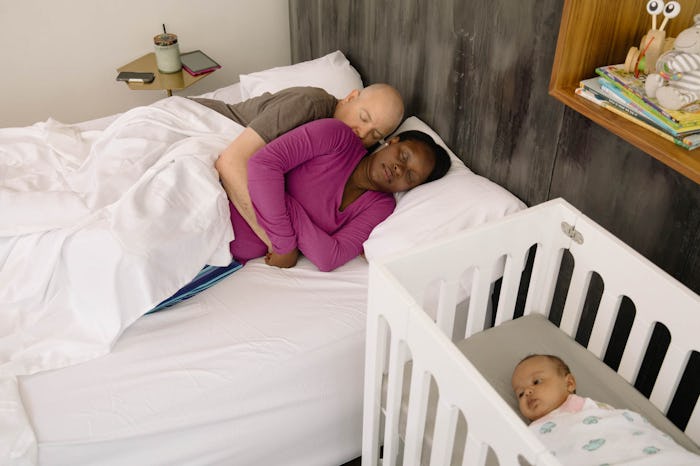As your due date nears, you've probably been thinking about where your baby should sleep. You've researched your options — your head is filled with the pros and cons of co-sleeping versus bed-sharing versus sleeping in different rooms — and you've decided that co-sleeping could be a good fit for you and your newborn. But how much does co-sleeping cost? Is it going to break the bank or will it save you a little cash? Fortunately, you have a lot of co-sleeper choices available to you.
Co-sleeping is a fancy-sounding concept that describes a very simple process — basically it's when parents sleep with their baby in the same room at night. It's important to note, too, that co-sleeping is different from bed-sharing, according to the National Sleep Foundation. While the terms are often used synonymously, co-sleeping refers to letting your baby sleep in your room but on a separate surface (like a crib) while bed-sharing refers to letting your baby sleep in your bed with you. Out of these two options, bed-sharing generally costs less than co-sleeping because you don't have to buy a separate sleeping apparatus for your baby — unless you want to spring for a newer and bigger mattress, of course.
If you've decided to co-sleep with your baby, your biggest cost will come from the type of co-sleeper you pick out, whether that's a simple crib or a cute bassinet or one of those European-style sidecar sleepers that you put on your registry just for fun. To get a feel for your options, the editors at Parenting magazine picked out five of their favorite bassinets, ranging from a $100 cradle to a splurge-worthy $400 cot and crib combination. Looking to save on space? Babble offers a rundown of crib alternatives, including an affordable Moses basket and a portable travel crib.
Because baby gear can get pretty expensive, another co-sleeper you can consider is a baby box — yes, it's just a cardboard box, though it does come with a firm mattress and sheet. While this idea might sound batty, baby boxes can lessen the risk of Sudden Infant Death Syndrome (SIDS) and have reduced the infant mortality rate in Finland for the last 80 years, as NPR reported. The baby box trend has recently spread to the United States, and the Baby Box Co. offers free boxes for parents who watch a series of educational videos and take a short quiz. But keep in mind that the boxes should always be placed on a sturdy surface — they are made out of cardboard — and that they should only be used for the first six months of your baby's life.
Baby sleep can be a complicated topic, but choosing a co-sleeper doesn't have to be. With so many options to choose from these days, you can pick a sleeper that best suits your family and your budget. Whether you opt for a box or a bassinet, just remember to place your baby on their back to sleep and to remove any toys or extra padding. And if at all possible, try to get a few winks in yourself.
